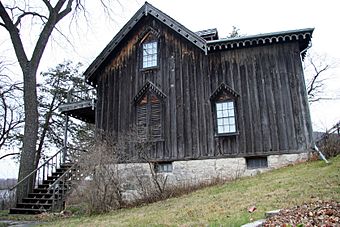Willard Bunnell House facts for kids
Quick facts for kids |
|
|
Willard Bunnell House
|
|

The Willard Bunnell House from the west
|
|
| Location | 36106 Old Homer Road, Homer, Minnesota |
|---|---|
| Area | 1 acre (0.40 ha) |
| Built | c. 1850s |
| Architect | Willard Bunnell |
| Architectural style | Carpenter Gothic |
| NRHP reference No. | 73000998 |
| Added to NRHP | April 23, 1973 |
The Willard Bunnell House is a special old house in Homer, Minnesota, United States. It is now a historic house museum, which means you can visit it to learn about the past. This house was added to the National Register of Historic Places in 1973. It was important because of its unique design, its role in trade, and how it helped settle the area.
People say it was the first permanent house built south of Saint Paul in Minnesota. It also shows off a cool style called Gothic Revival architecture. The house is linked to two brothers, Willard (who lived from 1814 to 1861) and Lafayette Bunnell (who lived from 1824 to 1903). They were very important in helping this area grow when it was still a frontier. Today, the Winona County Historical Society takes care of the house.
Contents
About the House
The Willard Bunnell House is located about 3 miles (5 km) east of Winona, Minnesota. It sits on a hill, looking over U.S. Route 61 and the mighty Mississippi River. The house is made of unpainted eastern white pine wood. It has a simple design with vertical boards and thin strips covering the gaps.
House Style and Features
The house is built in the Carpenter Gothic style. This means it has pointed, triangle-shaped windows and decorative wooden trim. You can see carved bargeboards, which are fancy boards along the edges of the roof. But the house also has some unusual parts. These parts are more like buildings found near the Ohio River and the lower Mississippi River. For example, it has a two-story porch called a veranda and a flat-roofed section at the back.
The Bunnell Brothers' Story
Willard Bunnell was born in 1814. He started working on steamboats on the Great Lakes as a cabin boy. He worked his way up to become a captain. In 1837, he married Matilda Desnoyer in Detroit. Willard became very interested in helping to open up the American frontier. He even helped survey a special military road from Detroit to Mackinaw. After that, he started trading with the Ojibwe people near the Escanaba River.
Moving West
In 1841, Willard and Matilda Bunnell, along with Willard's younger brother Lafayette, traveled to the Upper Mississippi River. They eventually settled in Trempealeau, Wisconsin. From 1845 to 1846, Lafayette Bunnell worked in logging. He helped float logs down the Chippewa River. This was a short-lived effort, but it showed what would become a big industry in the area. The brothers also helped build the first sawmill on the Eau Claire River. This mill later led to the city of Eau Claire, Wisconsin.
Settling in Minnesota
In the late 1840s, Lafayette went back east and joined the military. Willard stayed on the Upper Mississippi. At that time, the land across the river was still owned by the Dakota people. White settlers were not allowed to live there. But Willard thought things would change. He got permission from Chief Wabasha III to build a log cabin on the west bank of the Mississippi.
In 1852, a new agreement called the Treaty of Traverse des Sioux opened up much of Minnesota Territory for white settlement. Over the next few years, Willard Bunnell helped start three new towns. These were Minneowah, Chatfield, and Homer. He thought that Winona would not do well because he believed it would flood often. However, Winona did not have many floods and grew into a successful community. Bunnell's towns stayed small.
Building the House
Around this time, Willard also built a new, bigger home next to his and Matilda's first log cabin. This is the house that you can still see today. The house might not have been completely finished when Willard passed away in 1861. His brother Lafayette had served as a surgeon in several wars, including the Mexican–American War and the Civil War. He was also part of the first Euro-American exploration of the Yosemite Valley. Lafayette moved into the house in 1865 and lived there until he passed away in 1903.
See also



